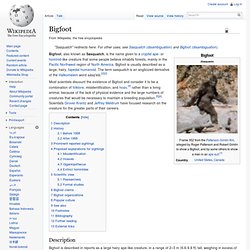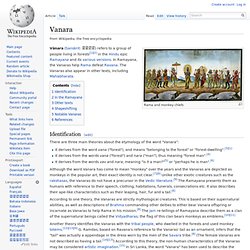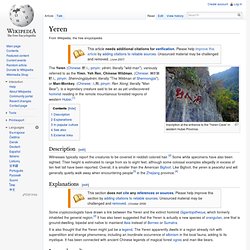

Bigfoot. Bigfoot, also known as Sasquatch, is the name given to a cryptid ape- or hominid-like creature that some people believe inhabits forests, mainly in the Pacific Northwest region of North America.

Bigfoot is usually described as a large, hairy, bipedal humanoid. The term sasquatch is an anglicized derivative of the Halkomelem word sásq'ets.[2][3] Most scientists discount the existence of Bigfoot and consider it to be a combination of folklore, misidentification, and hoax,[4] rather than a living animal, because of the lack of physical evidence and the large numbers of creatures that would be necessary to maintain a breeding population.[5][6] Scientists Grover Krantz and Jeffrey Meldrum have focused research on the creature for the greater parts of their careers. Description History Before 1958 Wildmen stories are found among the indigenous population of the Pacific Northwest. Members of the Lummi tell tales about Ts'emekwes, the local version of Bigfoot. Local legends were compiled by J. Hibagon.
The Hibagon (ヒバゴン?)

Or Hinagon (ヒナゴン?) [citation needed] is the Japanese equivalent of the North American Bigfoot[citation needed] or the Himalayan Yeti. [citation needed] History of the Hibagon[edit] The Hibagon is described as a "black creature with white hands and large white feet, standing about five feet tall. " Sightings have been reported in "forested, mountainous areas of the country," [1] around Mount Hiba[citation needed] in the Hiroshima Prefecture[citation needed] and has been said to resemble a gorilla.[2] "The Hibagon has a large nose, large deep glaring eyes and is covered with bristles.
A sighting from 1972 reports that the creature "has a chocolate brown face and is covered with brown hair ... Japanese Boy Scouts, "claim to find footprints 25 cm (10 in) long and 15 cm (6 in) wide. " As with "most hominid cryptids, the Hibagon is said to have a most unpleasant stench, like a dead human body Popular culture[edit] Shug Monkey. The Shug Monkey is a cryptid or mythical creature reported from the area of Cambridgeshire between the villages of Balsham and West Wratting.[1] Folklorists and investigators of the supernatural classify it as closely related to British hellhounds such as Barghest and Black Shuck, more distantly related to werewolves and the woodwose.

[citation needed] Cryptozoologists classify it as either a cryptid canine or as a cousin of Bigfoot. Sun Wukong. One of the most enduring Chinese literary characters, Sun Wukong has a varied background and colorful cultural history.

For example, Sun Wukong is considered by some scholars to be influenced by both the Hindu deity Hanuman from the Ramayana and elements of Chinese folklore.[2][3][4] Vanara. Vānara (Sanskrit: वानर) refers to a group of people living in forests[1][2] in the Hindu epic Ramayana and its various versions.

In Ramayana, the Vanaras help Rama defeat Ravana. The Vanaras also appear in other texts, including Mahabharata. Identification[edit] There are three main theories about the etymology of the word "Vanara": It derives from the word vana ("forest"), and means "belonging to the forest" or "forest-dwelling".[3][1]It derives from the words vana ("forest") and nara ("man"), thus meaning "forest man".[4]It derives from the words vav and nara, meaning "is it a man?
" Yeren. Inscription at the entrance to the "Yeren Cave" in western Hubei Province.

The Yeren (Chinese: 野人; pinyin: yěrén; literally "wild-man"), variously referred to as the Yiren, Yeh Ren, Chinese Wildman, (Chinese: 神农架野人; pinyin: Shénnóngjiàyěrén; literally "The Wildman of Shennongjia"), or Man-Monkey, (Chinese: 人熊; pinyin: Ren Xiong; literally "Man Bear"), is a legendary creature said to be an as yet undiscovered hominid residing in the remote mountainous forested regions of western Hubei.[1] Description[edit] Witnesses typically report the creatures to be covered in reddish colored hair.[2] Some white specimens have also been sighted. Their height is estimated to range from six to eight feet, although some colossal examples allegedly in excess of ten feet tall have been reported. Yeti. The Yeti or Abominable Snowman (Nepali: हिममानव, lit.

"mountain man") is an ape-like cryptid taller than an average human that is said to inhabit the Himalayan region of Nepal and Tibet.[3] The names Yeti and Meh-Teh are commonly used by the people indigenous to the region, and are part of their history and mythology. Yowie. Yowie is one of several names given to a mythical hominid reputed to live in the Australian wilderness.

The creature has its roots in Aboriginal mythology. In parts of Queensland, they are known as quinkin (or as a type of quinkin), and as joogabinna, in parts of New South Wales they are called jurrawarra, myngawin, puttikan, gubba, doolaga, gulaga and thoolagal. Other names include yahoo, yaroma, noocoonah, wawee, pangkarlangu, jimbra and tjangara.[2][3] As is the case with the North American Sasquatch, many people discount the existence of the yowie considering it more likely to be a combination of misidentification, folklore and hoax. Yowie-type creatures are common in Aboriginal Australian legends, particularly in the eastern Australian states.